What are the desert animals? How do they live, Which animals are capable to live on the desert, info on them.
The desert can be successfully inhabited only by animals possessing some suitable means of dealing with the intense heat and the scarcity of water. The high desert temperatures and the limited water supply inevitably produce a conflict within the animal between retaining water for bodily functions and transpiring (evaporating) it for cooling purposes. Excessive transpiration usually results in desiccation (drying) and death. The rate at which water is lost through transpiration depends largely upon the size of the body’s surface: the larger the surface, the greater the rate. Because smsill animals have a large body surface compared to their size, they are very susceptible to desiccation. At high rates of transpiration the loss of body water in small animals quickly reaches lethal extremes.
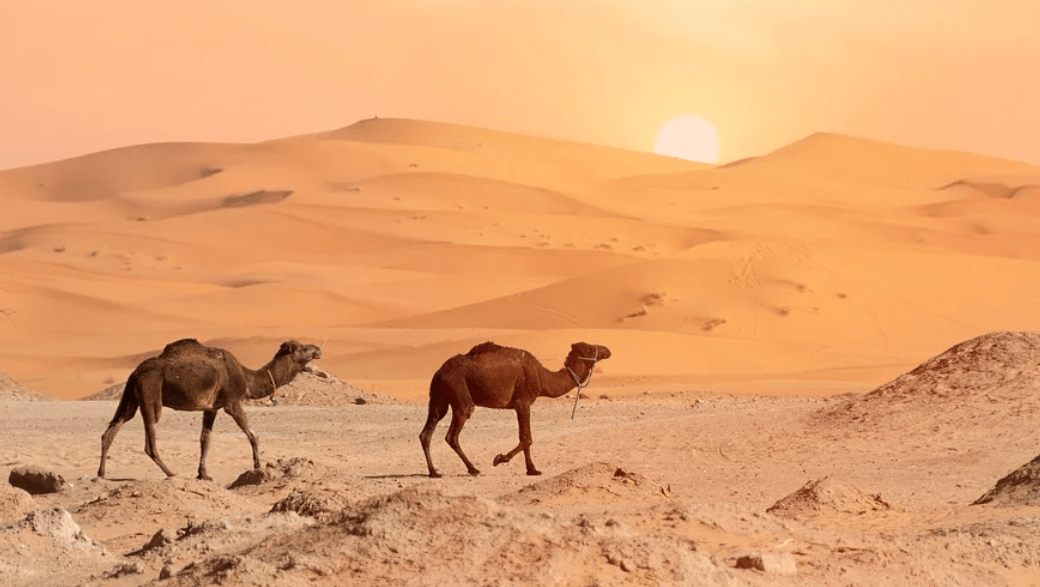
Source : pixabay.com
If a flea, for example, transpired at the rate of 5 milligrams per square cm per hour (roughly, an hourly loss of 1/1,000 of an ounce of water per square inch of body surface) for a period of 15 minutes, it would lose 10% of its body water. A man would have to transpire 4,500 times as fast to lose the same percentage in the same period of time.
Small animals, therefore, can exist in the desert only by avoiding climatic extremes. This they achieve by sheltering or burrowing underground during the day and coming out at night when the temperature falls and the relative humidity of the air increases. In larger forms the prevention of water loss by transpiration is less important, because a given rate of transpiration can proceed for much longer before the content of body water falls to a lethal level. So, although large animals are unable to escape the rigors of the desert climate in the same way as smaller ones, they can beter afford to lose water through evaporative cooling.
Insects and Arachnids:
The animals principally represented in arid regions are insects, arachnids (spiders, scorpions, and others), reptiles, birds, and mammals. The adaptations of insects and arachnids to hot, dry environments consist of heat-avoiding behavior, remarkable hardiness, and an efficient utilization of available water.
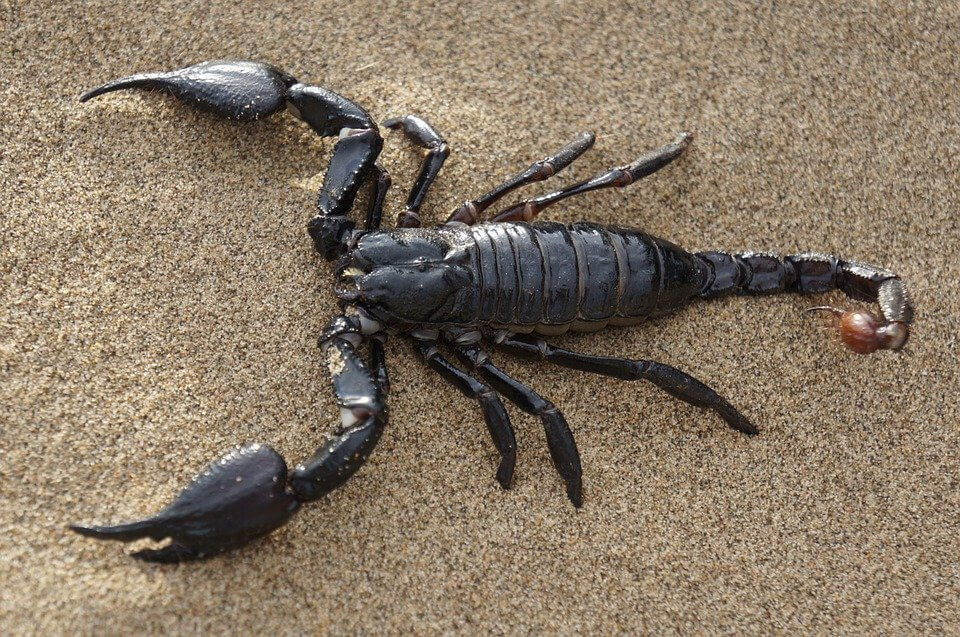
Source : pixabay.com
The adaptive behavior includes burrowing, nocturnal habits, seasonal rhythms of activity, and a dormant stage during development that coincides with the dry season. The uncommon hardiness involves the ability to withstand extremes of starvation, dehydration, and high temperatures. The efficient utilization of available water is achieved in various ways: most commonly, there is the ability to conserve metabolic water (water formed during the oxidation and breakdown of food molecules); many desert species also transpire more slowly than their relatives in moister parts of the world; and some, by a remarkable process that is not fully understood, are actually able to absorb moisture from unsaturated air through their body surface (integument ).
Reptiles:
Reptiles are conspicuous and comparatively numerous desert animals. They have a relatively impervious, scaly skin that greatly reduces the loss of body water by evaporation and effectively restricts such water loss to the saturated breath expelled from the lungs during breathing. Their urinary wastes are usually eliminated as a pulpy, semisolid mass, predominandy of uric acid, with little accompanying water. The reptiles’ diet supplies adequate water, and evaporation can be greatly reduced by daily or seasonal periods of rest within a cool, humid burrow.
Reptiles can regulate their body temperature, but they do so by behavior rather than physiological means. The animals sun themselves until their body temperature has risen to its optimum; then they hide away in holes or crevices to prevent overheating. When it is very hot, the African tortoise Testudo sulcata can maintain a body temperature of about 105° F (40.5° C) by copious salivation, which wets the head, neck, and front legs. This draws heavily upon the tortoise’s body water, however, and cannot be sustained for prolonged periods.
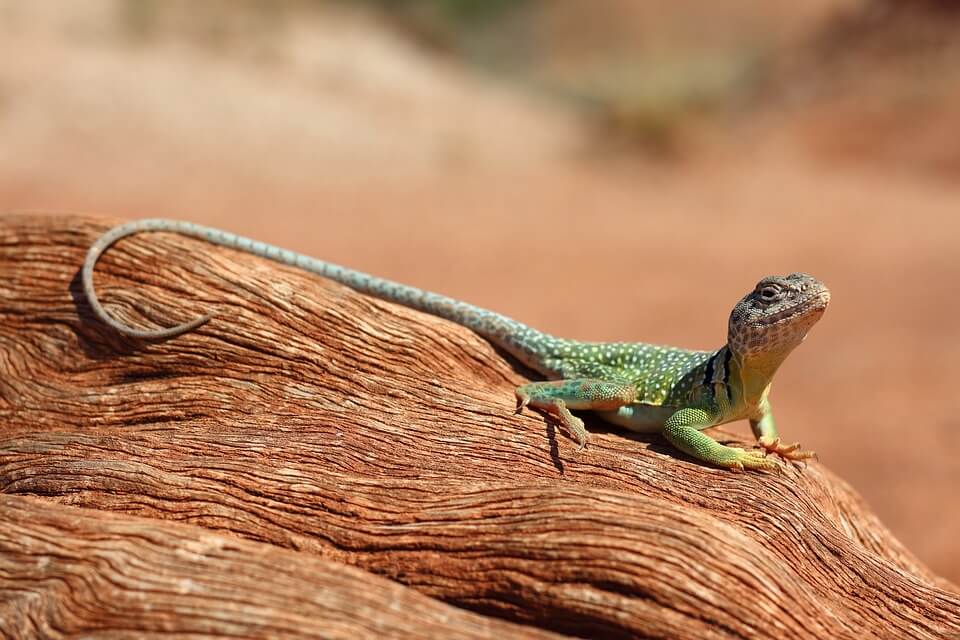
Source : pixabay.com
The lizards of sandy regions show two kinds of adaptation to the environment, according to whether they are “sand runners” or “sand swimmers.” In the former, the toes of both the front and the hind feet are fringed with elongated scales. These scales, functioning like snowshoes, widen the surface that presses on the loose sand. When not running, a sand runner stands alert, with head held high and the front part of the body raised on the forelimbs so that it clears the hot sand. In motion, the animal holds its tail well above the ground as a counterpoise. Such adaptations are found in many unrelated species from different parts of the world.
Sand swimmers include skinks and other lizards, as well as some snakes that are adapted for rapid burrowing in loose sand. In these, the nose is pointed and shovel-like, and the nostrils tend to be directed upward instead of forward. In most of these sna.kes the nostrils are shielded from the sand by complicated valves, or they are reduced to pinhole size. Some species of sand swimmers dive headfirst into loose sand as though it were water. Others have widened bodies for burrowing by lateral and vertical movements instead of plowing forward into the sand. Some snakes, such as the American sidewinder (Crotalus cerastes) and African and Asiatic horned vipers of the genus Aspis, progress across the sand by utilizing a helical (spiral) side-winding movement.
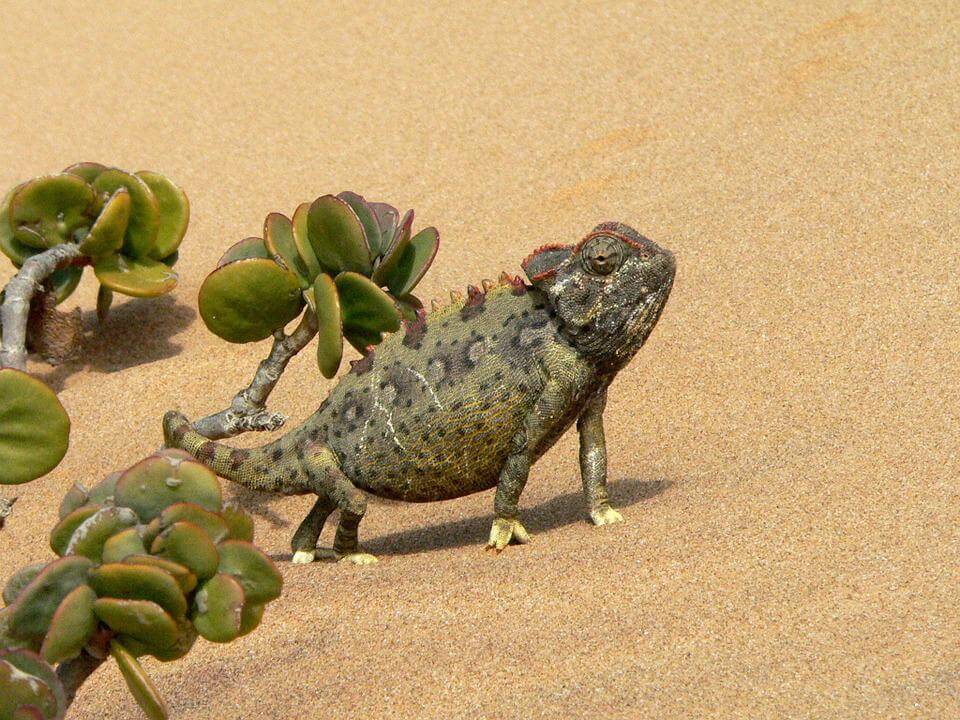
Source : pixabay.com
Birds:
Although many species of birds live in desert regions, most of these inhabit the fringe of the desert and never go far from water. The most serious physiological factor limiting the distribution and dispersion of desert birds is water loss by evaporation. Small birds lose water by evaporation very much more rapidly than mammals of comparable size, and most of this is lost in panting rather than through skin transpiration. It has been suggested that this greater evaporation loss in birds occurs because their body temperatures are higher that those of most mammals. The air expired from the bird’s lungs is therefore warmer and can and does hold a higher moisture content. Thus, small birds can survive in the desert only by drinking or by eating very succulent food.
To conserve body water, birds utilize shade to protect themselves from the full heat of the sun, but they are also physiologically adapted to tolerate a rise in body temperature without ill effects. This allows them to retain body water that would otherwise be used to dissipate accumulated body heat. Desert birds also can quickly make up severe water loss by drinking, in contrast to some animals that may suffer ill effects in attempting to drink enough at one time to compensate fully for the loss.
Thus the capacity of the American mourning dove (Zenaidra macroura) to endure elevated body temperature and extensive dehydration, combined with the ability to make up water deficit and to fly long distances, allows this species to meet the demands of a desert existence.
The large, flightless ostrich (Struthio camelus), though it must drink water or eat very succulent food for adequate water intake, possesses special salt-excreting glands that enable it to live off brackish or even salty water without ill effects. These glands, located in the head near the eyes, remove salt from the blood and discharge it through the nasal passages. The ostrich also can rapidly make good the loss in weight resulting from dehydration.
Besides physiological specializations, the adaptations of birds to arid habitats include behavioral and ecological factors. Sandgrouse (Pterocles), common inhabitants of African and Asiatic deserts, feed and nest far away from rivers and lakes. These birds have adopted an extraordinary method of providing moisture for their young. As the sun rises, great flocks of these small birds fly many miles to water. Before reaching the watering sites, the male birds rub their breasts on the ground until the feathers are awry and easily saturated while they are drinking. They then fly back to the nesting area, where the young take turns in passing the wet feathers through their beaks until the supply of moisture is exhausted. Before they can fly, the young take water in no other way.
The eggs of birds that nest on the desert surface are rapidly killed by heat if left uncovered during the day. Only the largest egg, that of the ostrich, can survive prolonged exposure to the desert sun. Many desert birds, therefore, nest in the shelter of bushes, in holes, caves, or crevices, or under boulders.
Mammals:
The mammals most independent of water are the desert rodents known as kangaroo rats (Dipodomys), gerbils (Gerbillus and others), and jerboas (Jaculus and others). These can subsist solely on the metabolic water obtained from the oxidation and breakdown of dry food. The use of burrows as living sites by these rodents is of special significance in this regard. Microclimatic measurements of temperature and humidity within the burrows have shown that, although the air is not saturated, its moisture content is higher than that of the air outside. Consequently, the rate of water evaporation from the rodents’ lungs is considerably reduced. If the animals were to breathe the air outside their burrows continually, the rate of evaporation from the lungs would exceed the rate of formation of metabolic water.
The burrows, in addition to being moist content, are relatively cool. The coolness of the burrow reduces the temperature, and hence the moisture-carrying capacity, of the expired air as it leaves the nose. Because of these humidifying and cooling effects, the rodents inhabiting burrows have a lower rate of water evaporation from the lungs than that of most other mammals.
These rodents also possess physiological specializations for the conservation of body water. They produce both an extremely concentrated urine, enabling them to use less water in excreting waste products, and have dry feces. The North African sand rat (Psammomys obesus), which lives on succulent but saltv plants found on intermittently dry stream beds, is the most exceptional in this respect: it can produce a urine nearly four times as salty as seawater, enabling it to utilize the saline water contained within its plant diet.
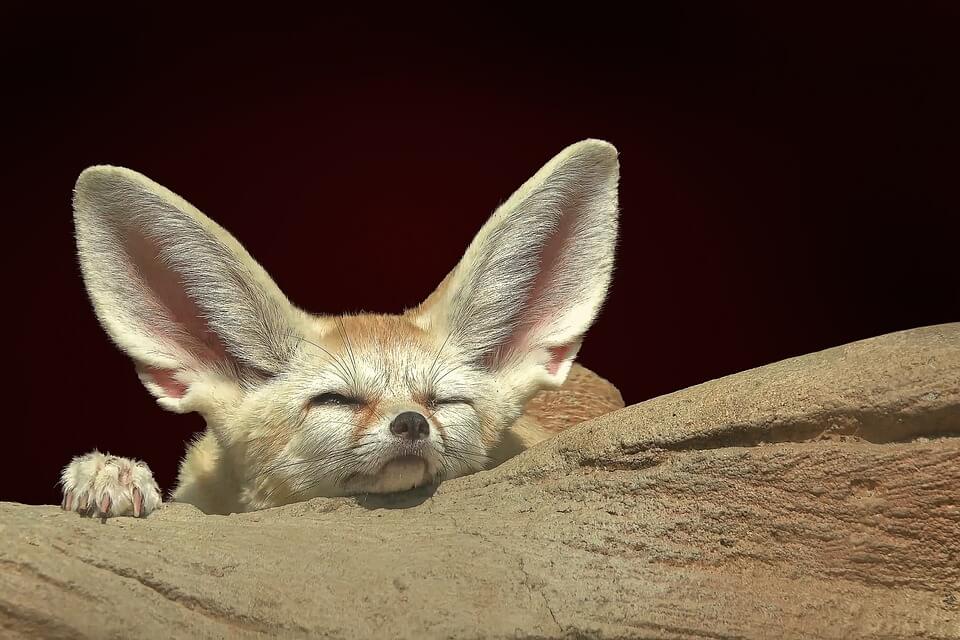
Source : pixabay.com
Desert rodents, like other small mammals, do not sweat. It seems likely that the general absence of sweat glands in small mammals results from the necessity to reduce the high rate of water loss caused by their relatively large surface areas. A kangaroo rat or jerboa, for’example, in order to maintain a constant, normal body temperature when the surrounding temperature is 104° F (40° C), would have to lose 20« of its body weight in water each hour. Though they do not sweat, such mammals have an emergency temperature-regulating process: if the body temperature approaches the lethal level, about 107.5° F (42° C), the animal salivates copiously, wetting the fur of its chin and throat. The cooling effect of this procedure may keep experimental animals alive for up to half an hour at temperatures fatal to other small rodents.
Aestivation, the summertime equivalent of hibernation, occurs in a number of desert rodents. The ground squirrel (Citellus), for example, becomes torpid and aestivates during the summer and early autumn. Its body temperature falls to that of the air, and its metabolic rate, respiration, and other physiological processes are reduced, permitting the animal to live without food and decreasing the evaporation of water from the lungs. Especially important is the fact that with a lowered body temperature, less water is required to saturate the expired air.
Little is known about carnivorous desert mammals, but there is no doubt that they obtain considerable quantities of water from their food. The fennec fox, in addition to its catholic diet of insects, lizards, rodents, and plant material, exhibits a number of characteristics typical of a desert inhabitant. It is much smaller than its relatives from temperate climates; it has large eyes and ears; and it spends; the day in a burrow, thus avoiding extremes of heat.
Large desert mammals, such as antelopes and camels, cannot escape daytime heat by burrowing: they must either endure a rise in body temperature or expend water for heat regulation, and, in fact, they do both. Camels, besides tolerating a wide range of body temperatures, can also lose about 30% of their weight in body water without ill effects and can make up the loss at one drinking without suffering water intoxication. The gazelle, however, has become adapted to the desert not so much physiologically as by its speed and ability to travel great distances to obtain food and water.
Strictly behavioral responses to the intensity of the sun are seen in large desert animals. Any available shade is utilized, and camels, as well as sheep and goats, orient their bodies to reduce the area of body surface exposed to the sun’s rays. When an animal’s head faces the sun, a smaller area of its body is heated than if the sun were shining on its side.